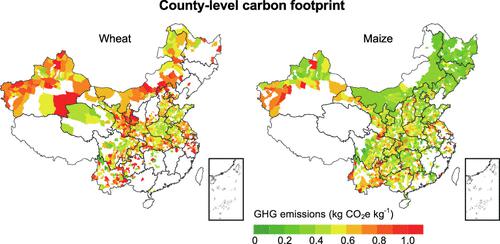当前位置:
X-MOL 学术
›
Environ. Sci. Technol.
›
论文详情
Our official English website, www.x-mol.net, welcomes your
feedback! (Note: you will need to create a separate account there.)
Closing Greenhouse Gas Emission Gaps of Staple Crops in China
Environmental Science & Technology ( IF 10.8 ) Pub Date : 2022-06-21 , DOI: 10.1021/acs.est.2c01978 Yize Liu 1 , Weiyi Gu 2 , Beibei Liu 2 , Chao Zhang 3 , Chun Wang 4 , Yi Yang 5 , Minghao Zhuang 1, 6
Environmental Science & Technology ( IF 10.8 ) Pub Date : 2022-06-21 , DOI: 10.1021/acs.est.2c01978 Yize Liu 1 , Weiyi Gu 2 , Beibei Liu 2 , Chao Zhang 3 , Chun Wang 4 , Yi Yang 5 , Minghao Zhuang 1, 6
Affiliation

|
China is facing the dual challenge of achieving food security and agricultural carbon neutrality. Developing spatially explicit crop emission profiles can help inform policy to mitigate agricultural greenhouse gases (GHGs), but previous life-cycle studies were conducted mostly at national and provincial levels. Here, we estimate county-level carbon footprint of China’s wheat and maize production based on a nationwide survey and determine the contribution of different strategies to closing regional emission gaps. Results show that crop carbon footprint varies widely between regions, from 0.07 to 3.00 kg CO2e kg–1 for wheat and from 0.09 to 2.30 kg CO2e kg–1 for maize, with inter-county variation generally much higher than interprovince variation. Hotspots are mainly concentrated in Xinjiang and Gansu provinces, owing to intensive irrigation and high plastic mulch and fertilizer inputs. Closing the regional emission gaps would benefit mostly from increasing crop yields and nitrogen use efficiency, but increasing manure use (e.g., in Northeast, East, and Central China) and energy use efficiency (e.g., in North and Northwest China) can also make important contributions. Our county-level carbon footprint estimates improve upon previous broad-scale results and will be valuable for detailed spatial analysis and the design of localized GHG mitigation strategies in China.
更新日期:2022-06-21











































 京公网安备 11010802027423号
京公网安备 11010802027423号